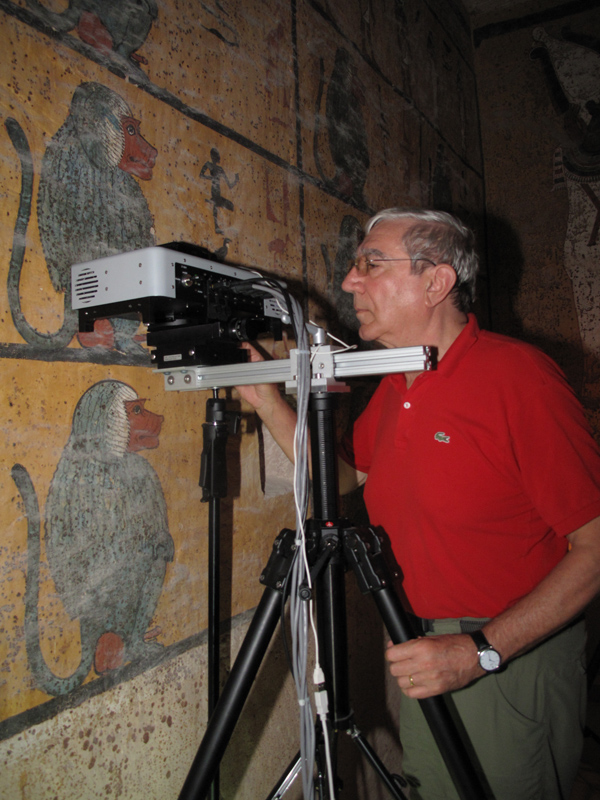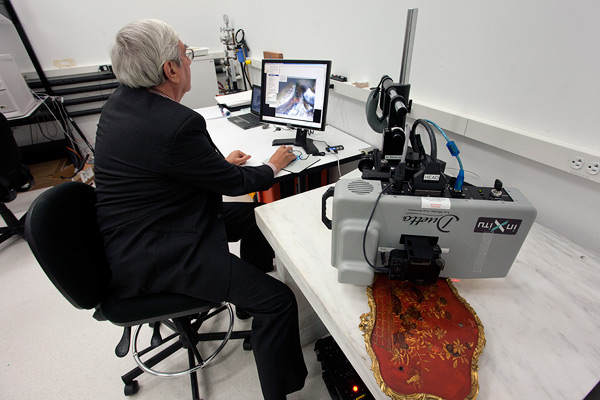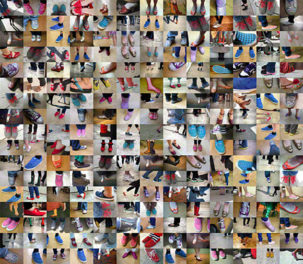
Giacomo Chiari, head of the science department at the Getty Conservation Institute, examines the painting on the west wall in the tomb of King Tutankhamen. Photo: Lori Wong (c) J. Paul Getty Trust
This coming weekend, NASA’s latest Mars Rover, Curiosity, is scheduled to touch down on the Red Planet to begin two years of scientific discovery, helping scientists unlock some of the planet’s as yet undiscovered secrets.
Interestingly, the same technology being used in space — a key part of a tool the Rover will use to gather data about Mars — is also now being used on planet Earth to help unlock the analytical mysteries of important works of art, and it is revolutionizing the conservation field.
“Until recently, few analytical choices were available that did not necessitate sampling,” or taking a tiny piece of an artwork for study, says Giacomo Chiari, chief scientist at the Getty Conservation Institute (GCI). “But the development of non-invasive, portable instruments, like the one on the Mars Rover, has greatly changed the art conservation landscape.”
Analysis is a fundamental part of conservation science. Conservation scientists apply analytical procedures to important works of art and architecture to establish what an object is made of and how it was made, as well as where it was created. Research also reveals how materials change over time, and suggests ways to slow their deterioration. This information helps art historians, archaeologists, and conservators to better understand the objects they are studying and conserving.
During the past 50 years, the field of conservation has developed a philosophy that respects the material integrity of objects – an approach of minimal intervention. Which means that when information is needed about an art object in the quest to conserve it, the last resort of scientists and conservators would be to take a sample for scientific analysis – even a miniscule one.
As well, it’s inherently risky to bring a work of art to the laboratory for analysis because the work might be damaged during transportation. Some items simply cannot be moved due to size, condition, or other considerations.
So what is a scientist to do? Look to space.
NASA developed an innovative X-ray diffraction and fluorescence instrument deployed on Mars in 2010 as part of the Mars Science Laboratory Rover to help scientists take a closer look at the surface of the planet. This was a long-range effort requiring extreme portability and accuracy.

This artist’s concept features NASA’s Mars Science Laboratory Curiosity rover, a mobile robot for investigating Mars’ past or present ability to sustain microbial life. Curiosity will land near the Martian equator about 10:31 p.m., Aug. 5 PDT (1:31 a.m. Aug. 6 EDT). In this picture, the rover examines a rock on Mars with a set of tools at the end of the rover’s arm. Image: NASA/JPL-Caltech
Giacomo was immediately interested in finding out how this new technology could be redeveloped for use in analyzing artworks. He contacted California-based company inXitu, which developed the original technology, and the firm’s chief technology officer Philippe Sarrazin collaborated with the GCI to adapt and build a portable instrument for art analysis.
“The instrument was redesigned for us to reflect x-rays off a surface, avoiding the need for sample collection, rather than using transmission mode, which would require the x-ray detector to be placed beneath the object surface,” Giacomo explained to me. “For our purposes, we can’t always place something beneath the object, so being able to reflect the x-rays off of the surface and obtain accurate results was key.”
On location, the instrument, dubbed the Duetto, is adjusted in front of the artwork using precise laser alignment guides and a high resolution camera, such as in the picture of Giacomo working in the tomb of Tutankhamen as part of the GCI’s project there, above. A fine x-ray beam is directed at the surface and the radiation scattered back is collected by an energy-dispersive detector that allows the diffraction and fluorescence signatures to be measured simultaneously in minutes.
“The combined diffraction and fluorescence data can differentiate not only between some common salts but also between hydration states, which may pinpoint the causes of deterioration and lead to the design of a suitable conservation strategy for an art object,” he says.
The Duetto is being used to analyze the collection of antiquities, outdoor sculpture and manuscripts at the Getty. It also is being used by GCI scientists at the Roman ruins of Herculaneum, Italy, to examine excavated wall murals for pigments, salts and deterioration.

Giacomo Chiari, head of the science department at the Getty Conservation Institute, examines a lacquered base with gilt bronze mounts that was part of an ink stand from 18th- century France.
Of course, all portable instruments come with limitations, cautions Giacomo. Miniaturization and portability can compromise accuracy and sensitivity if not used correctly. The more user-friendly nature of portable instruments may entice non-experts to use them, with less than accurate results. Certain studies still require samples to be taken.
Even with those challenges, Giacomo feels the use of such portable diagnostic instruments will solve many key problems, such as analyzing precious manuscripts without taking samples, or analyzing heavy statues, marble works and outdoor murals that cannot be moved.
“To implement this technology skillfully, I see an increasing need for a new future role in art conservation – that of the ‘scientist-conservator’,” says Giacomo. “With a combined knowledge of artists’ methods, conservation science and technical instruments, these professionals will be able to ask the right questions to conserve our future.”
And all of that can be done right here on Earth.




A most interesting recent advance through skilful adaption of a new technology for alternative uses.It will greatly assist future analysis of Old Master Paintings and Drawings and I look forward to hearing more of its development and research use. With kind regards, Graeme
awesome!